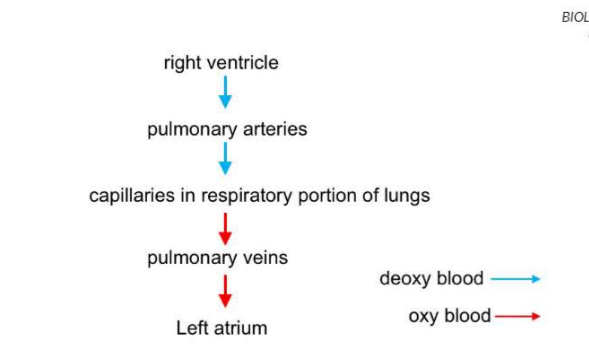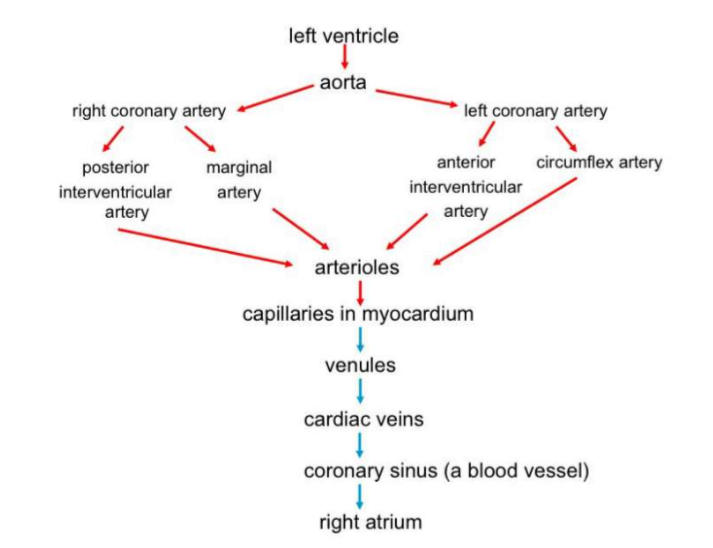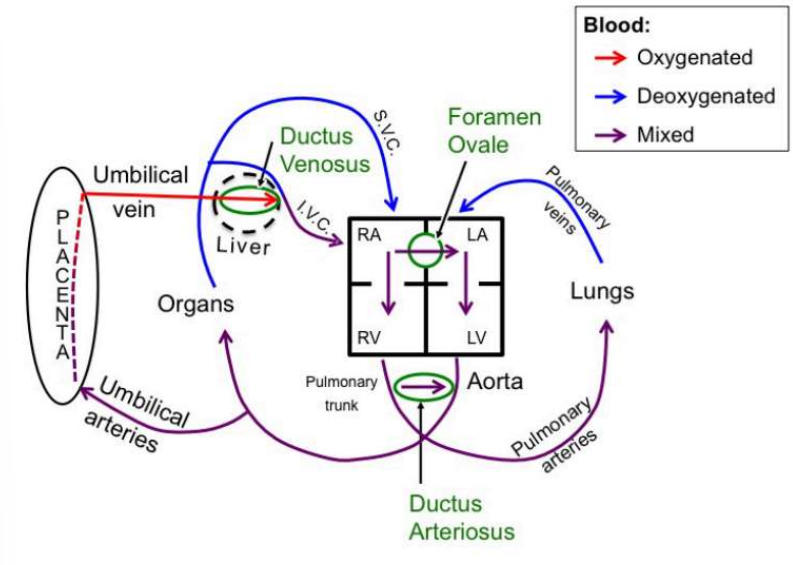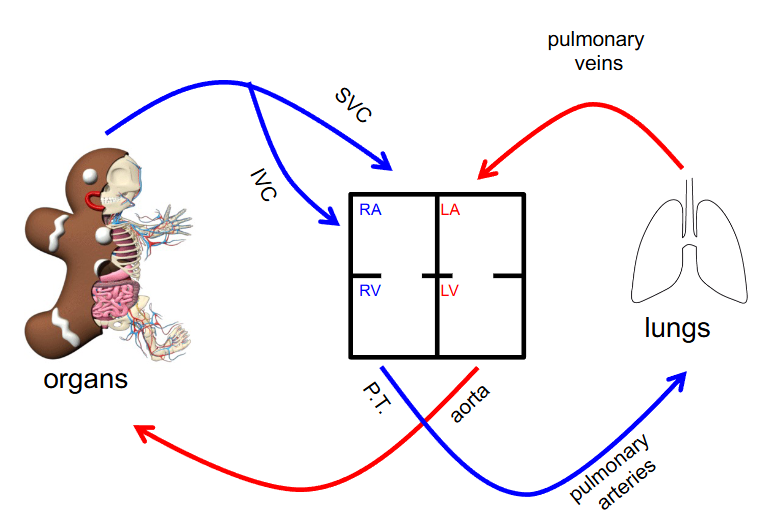What does closed, double circulation entail?
closed = blood confined to heard and blood vessels
double = 2 routes (pulmonary and systemic)
What are the 3 circulations in adult circulation?
pulmonary circulation, systemic circulation, and coronary circulation
What is pulmonary circulation for? what does it do?
- its for oxygenated of the blood
- carries blood from right ventricle to lungs (deoxygenated blood via pulmonary arteries)
- picks up oxygen in lungs via capillaries
- carries blood from lungs to left atria (oxygenated blood via pulmonary veins)
What is the route of pulmonary circulation?

What does systemic circulation do?
- for delivery of oxygenated blood to all other tissues
- carries (oxygenated) blood from left ventricle to organs via aorta
- organs take oxygen from blood via capillaries
- carries deoxygenated blood from organs to right atrium via superior and inferior vena cava
- many subdivisions of routes to individual organs/organ systems
What is coronary circulation?
- the system of vessels around the heart
What is the path of coronary circulation?

What is general over view of fetal circulation?
- fetus get oxygen and nutrients, and expels wastes to mothers blood
- exchange site in the placenta
What are the differences between fetal and adult circulation?
- umbilical vein (towards fetal heart) carries oxygenated blood from placenta to vena cava
- lungs and liver are late to develop and their functions are handled by maternal organs
umbilical arteries (away from fetal heart( returns mixed blood to placenta
How do fetus rely on maternal organs in circulation?
- 3 shunts allow most blood to bypass these organs (minimal blood flow to these organs for growth)
- following birth all shunts normally become closed
What are the 3 fetal shunts?
- ductus venosus (connects umbilical vein to inferior vena cava, permits most oxy blood to bypass liver capillaries)
- foramen ovale (hole in interatrial septum, allows blood to move from right to left atrium bypassing fetal lungs)
- ductus arteriosus (connects pulmonary trunk and aorta, bypassing fetal lung)
What is the path of fetal circulation?

What are the characteristics of blood?
- higher viscosity than H20
- pH 7.35 - 7.45
- 4 - 6L in an adult
What is blood composed of?
- plasma (matrix) makes up 55-60% of volume (fluid portion with solutes)
- formed elements make up 40-45% of volume (cellular portion)
What are the composition details of plasma?
- composed of H20 (90%), proteins (8%), and other solutes (2%)
What are the proteins in plasma?
- albumins (most plentiful plasma protein, carries substances (hormones, enzymes, etc) through body, helps tissue water balance)
- fibrinogen (clot formation)
- globulin (antibodies, detect and bind foreign invaders)
- protein based hormones and enzymes
What other solutes than proteins are in plasma?
nutrients, vitamins, wastes, electrolytes, blood gases (oxygen and carbon dioxide)
What are the formed elements in blood?
- red blood cells (erythrocytes, most abundant cell in body)
- White blood cells (leukocytes)
- platelets
What are platelets?
- fragments of cells called megakaryocytes
- involved in clotting
- life span ~10 days (if not used in clotting)
What are red blood cells?
- binds to and transports most of oxygen in blood
- anucleate when mature
- biconcave disk shape
- life span of ~ 120 days and old cells are destroyed in liver and spleen
What is hematocrit?
percent of blood volume made up by red blood cells (usually ~45%)
What do red blood cells contain?
- hemoglobin (iron-containing pigment protein)
- four globin chains (protein)
- four iron containing heme groups (gives blood red colour), 1 iron per heme and site of reversible oxygen binding
What are white blood cells (leukocytes)? What are theyre types?
- nucleated
- varying life span (days to years)
- defends against disease
- has two types: granulocytes (contain visible protein granules) and agranulocytes (lacks visible protein granules)
What do granulocytes include?
- neutrophils (~60%) kill bacteria, all phagocytic (engulf + digest invaders)
- eosinophils (~3%) attacks blood parasites
- basophils (~1%) release chemicals involved in inflammation and reduction of blood clotting during immune responses
What do agranulocytes include?
- lymphocytes (~35%) for immunity (two types)
- monocytes (~5%) enter tissues and enlarge to become macropages phagocytic
What are the two types of lymphocyte?
- T lymphocyte (activate immune response, kill tumour or virus infected/diseased cells directly
- B lymphocytes (become plasma cells that release antibodies to circulate in plasma)
What is hemopoiesis/hematopoiesis?
- formation of blood cells
- all blood cells arise indirectly from hemocytoblast cells (part of stem cells) in red bone marrow (located in adults in axial skeleton, pelvic & pectoral girdles, and proximal ends of humerus & femur)
What are related medical conditions to the cardiovascular system?
- atrial septal defect (hole in the interatrial septum)
- atherosclerosis (build up of fat deposits in the tunica intima that leads to narrowing or blocking of arteries)
What is the complete of the systemic and pulmonary circulatory systems?
